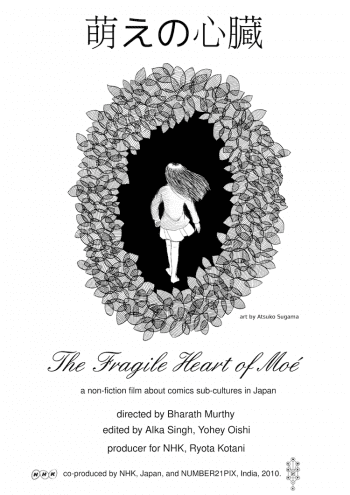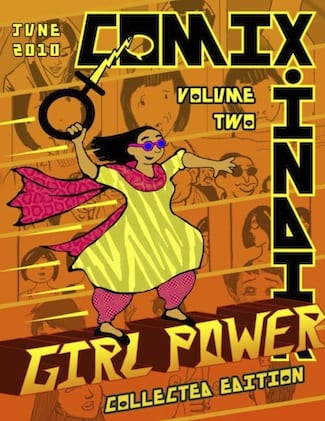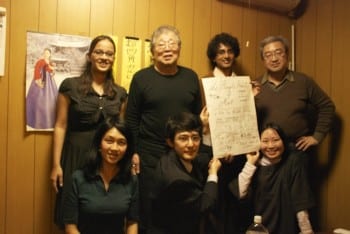 Changing direction now, tell me about your film, The Fragile Heart of Moe.
Changing direction now, tell me about your film, The Fragile Heart of Moe.
I had already done one film, set in India, a documentary for NHK in Japan. There was a series of half hour documentaries on contemporary India and I was one of the directors. This is was in 2007. It was about amateur pornography in India, about one particular film, one of the earliest amateur pornographic films in India, made in 2002, called Mysore Mallige. It was all over the internet. It has many names actually: Mysore Mallige, Coorgi Sweetie, Love in Karnataka. It concerns a couple, a Kannada-speaking couple in Mysore, and they film themselves having sex, a one-hour thing. But no one had seen anything like that in India before, at least on a large scale.
My understanding is that pornography is banned, at least officially, though you see pirate DVDs everywhere.
It is. It’s illegal, but that movie was all over the place. In CD stores, you could get a copy, under the table. And it was on the internet, and it’s still available on torrent. Nobody had seen anything like it. And because it went on to the net, even Indians abroad watched it, there was lot of discussion, urban legends grew about the couple, rumors that they committed suicide afterwards, many stories like that. So I wanted to make a film about the legend around it, and the fascination of young people with this documentary. I personally was fascinated with the film. I think it was a very good film in itself.
How did NHK choose you?
Through a pitching forum, at the film school where I was studying in Kolkata. NHK was one of the participants. I pitched the project to various international TV producers. The NHK producer was especially interested in the idea. I had already made one short film about the topic, and I showed that, and he was interested in pursuing it further. He liked the film, so subsequently he invited me to pitch another project to him personally, if there was something I was interested in doing in Japan. There was going to be a series called Tokyo Modern, looking at contemporary Tokyo culture through foreign eyes. He asked me if I had any ideas, and I jumped at the idea, being interested in manga.

I already had some exposure to manga in Japan, having visited Tokyo for the sound postproduction for the pornography documentary. So I was there for two weeks, visiting all of the manga shops, Mandarake first, then some manga cafés. I bought a whole load of manga magazines. It was the first time I was exposed to them. I bought a whole bunch just to show my Indian friends that this was what manga really was, that this is how they read them, and show them the low quality printing and how much could be done with it. I was attracted to that lo-tech, lo-fi approach to comics, as opposed to European luxury products, which were like French perfume. I liked that they were priced so low that anyone could afford them. It is truly a mass medium, and that really impressed me about manga. In fact that was the inspiration to do something similar in India, so that’s how I started Comix India.
Something similar to what exactly?
Similar to their amateur manga magazines, the dōjinshi. I had brought both back to India, the dōjinshi and the mass produced magazines. Of course that meant a lot of pornography. My suitcase was so heavy they stopped me at the airport in Tokyo, and they asked me to pay a hefty fee. I had to show them what was inside. It was all porn. But they let me go. All this porn manga . . . people at the Japan Airlines counter were really flustered.
No problem coming into India?
No no. That would have been a problem. I took a real risk.
Did the idea ever occur to you to do a porn dōjinshi in India?
Sure, I still want to do that.
Would it even be possible?
Yeah, on the net, anonymously. I have a real interest in pornography, and actually the initial idea for the moe film was to do something about porn manga. But gradually the subject shifted to dōjinshi culture as a whole. That was something I discovered only later, the whole Comiket phenomenon.
I imagine that crowd is much more accessible than, say, artists writing serials for adult porn magazines.
True, but we did interview quite a few of those kind of people as well. But it was very difficult to get access. They were suspicious, especially the magazine people, suspicious of channels like NHK. They thought it was NHK coming to interview them. I had to explain to them that it was a co-production, I am an Indian filmmaker and this was my film. After a lot of explanation, they granted me interviews.

Tell me about the film.
We started by interviewing all sorts of dōjinshi authors. Then we realized that the subject is too big to fit into a single film, so we decided to focus on women dōjinshi authors. And we wanted to give the viewer some kind of history of the dōjinshi movement. I was particularly attracted to women artists who had other careers. They would do these comics and try to sell them at the dōjinshi events. There was a whole network of women doing that. I found that very unique. So we decided to focus only on them. Some were housewives, some professionals doing dōjinshi as well. Through that we got to know about these genres that are very specific to women, those that emerged from dōjinshi culture, yaoi, boy’s love . . . so there’s an extended discussion about that.
Did all of this blow your mind coming from India, that there was this whole culture of comics for women, by women?
I felt a sense of relief more than anything else. It was good for me to see that there were so many women doing this. It was refreshing, having been exposed to Western and American comics, very male-centric, most of it, dominated by this idea that comics are for boys. That’s still the convention in India. So when I saw this stuff, I kind of connected to it on a cultural level as well, I thought I could understand where they were coming from. I thought and still do that there is something we can learn from manga culture, that we could start something in India like it, not big or anything, a dōjinshi comics scene, to try to get people to do comics and put them in a zine, and do it on an amateur level.

And that was the idea behind Comix India?
That was the idea behind Comix India. It’s basically amateurish work, and most of the contributors are first-timers, just trying out things. Many of them are too shy and didn’t want to show their work. But this gave them the opportunity to put their work out somewhere, to get some experience, and at least connect with other people.
My experience is that most Japanese dōjinshi are thin, single-artist books, self-published. There are not so many multi-artist anthologies like Comix India, with original work, rather than things derivative of major manga or anime titles.
Not as many, but there are quite a few. There are a lot of dōjinshi circles that do anthologies with five or six people, a closed circuit. I found a lot of those at Comiket, and especially at Comitia, which is only for original dōjinshi, not parodies. The guy who runs Comitia, Nakamura Kimihiko, is a very inspirational figure for many dōjinshi artists, and for me as well. He introduced us to women dōjinshi authors. It was thanks to him that we were able to interview so many people. At Comitia we found that the focus is not pornographic. There will be love and sex, but the focus is not pornography. Actually, for a lot of people, it’s literary.

I was always turned off by the dōjinshi scene. Everyone draws equally well, a lot of homogeneity in style and theme, a thousand shades of grey.
Comiket is like that, almost 80 percent pornography, and despised by ordinary Japanese people for that reason. Comitia, on the other hand, has a quite different vibe. It’s more like a literary event. And it has a side event where you can go and, for a price, read select works from the event, like a library. Not just fans, but very serious manga fans and critics, young people who read and write not just at a popular level, but engage with it at maybe a more academic or literary level . . . anyway at a much more serious level. We filmed that as well.
So Comix India was more inspired by Comitia rather than Comiket?
Yeah, I was impressed that people took comics at that level of seriousness. I was also very impressed by the personality of Mr. Nakamura, whom we did a long interview with.
(cont'd)






